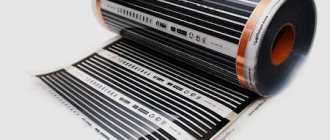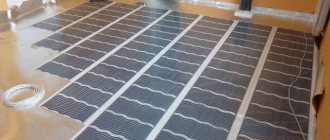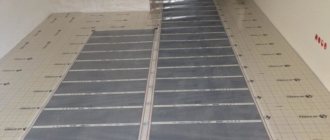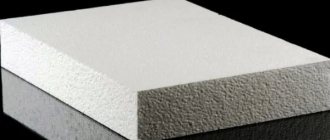Warm floors are no longer considered a novelty for construction technologies in our country. In total, two types of floor heating were used: water and electric. Such floors are used as the main or additional heating of buildings; they can be installed both in residential buildings and in kindergartens and commercial establishments. Now the most modern type of heated floors has appeared - infrared.
Infrared film floor
What are infrared floors, how do they differ from options well known to developers, are there any harm from them, what are their advantages and disadvantages? The question is very interesting, it is worth considering it in more detail. In order to better understand the essence of the problem, you should first consider what infrared heat is from a physics point of view.
Warm floor
What is infrared heat
Infrared heated floors are a successful marketing technique that allows you to increase the number of sales through the use of an unusual word for many, which evokes associations of a direct connection with “big science.”
What is infrared heat
What is this really?
There are three options for transferring heat from a hot body to a cold one:
- Convection. Hot air rises, cold air falls down. The temperature in the room is equalized throughout the entire volume due to the constant movement of air. Warm air heats our body with the kinetic energy of molecules. The higher the temperature, the faster they move, the more force they hit our body and transfer their energy to it. Due to such processes, we also heat up;
- By conduction . This heating method requires direct contact, heat transfer occurs only at the point of contact. Conduction combines two physical methods of body transmission: due to the kinetic energy of rapidly moving electrons of a heated body and due to radiation in the infrared segment;
- Infrared rays. Most objects on the planet are heated using this method. The sun is the main and most powerful source of rays in the infrared spectrum. All objects with a temperature above absolute zero (-273°C) emit infrared thermal waves. The higher the heating, the greater the intensity of infrared (thermal) radiation.
Infrared radiation (thermal)
The sun emits several types of waves: gamma rays, x-rays, ultraviolet, visible, infrared rays and microwaves. We are only interested in infrared. The length of these rays ranges from 0.74 µm to 100 µm.
Infrared rays
For reference. The human body emits rays of the infrared spectrum from 6 microns to 20 microns. The length is directly dependent on the heating temperature of the body. We provide this information for those who are terrified of the word “infrared.” From a physical point of view, “infrared” can be called water heating radiators, stoves, fireplaces, etc. That is, all objects that emit heat. If their temperature is higher than body temperature, then they are infrared heaters in relation to us. If lower, then they are infrared “absorbers”, absorb our waves and heat up due to them.
Characteristics of heated floors
Warm floors, as is already known, are divided into two categories:
- water;
- electric.
First of all, in order to avoid harm from using heated floors, it is important to use such heating as additional, and not primary. In this case, even if there is some kind of health threat, it will not be so significant
Of course, manufacturers will insist on the usefulness and quality of their product, but it’s better to track it yourself for what it really is. First of all, you need to find out the opinion of ordinary users, then doctors and engineers. None of the skeptics have yet been able to provide precise statements. There are only some guesses and prejudices that have not been proven. But still, in order to convince other users, it is better to tell more about the products under discussion.
The principle of operation of heated floors is that the air, already heated from below, rises. And due to the fact that such systems have a high level of heat transfer, the room warms up very quickly.
The most common argument made by skeptics regarding the impact of floors on human health is that underfloor heating systems have an electromagnetic field and can lead to overheating of the feet.
It is important for people to find out whether water or electric heated floors are harmful to their health, because they need to know as much as possible about the product they are using. In this case, the consumer should be familiar with both the positive and negative sides.
Harmful or safe infrared waves?
Infrared radiation on the spectrum of electromagnetic waves
Now, having a certain amount of knowledge, you can begin to consider the issue of the safety of infrared floors in comparison. But to do this, you need to know one more physical characteristic of infrared radiation - intensity. It is determined by the amount of energy emitted from a unit area of a heated body in watts. If the intensity of radiation does not cause overheating of the human body, then staying in such rooms is considered completely safe.
Conclusion. Infrared radiation is completely safe for our body. Of course, only in cases where it is not too intense and does not cause excessive heat or burns to the body.
This is all clear. But infrared floors are heated by electrical energy. This type of heating has its own characteristics that can have a negative effect on people. The fact is that electrical circuits always emit electromagnetic waves. But their effect on our body has not been fully studied. In modern development, medical science has established maximum standards for magnetic field indicators, which are generally considered safe. These data differ in different countries; a single criterion for assessing acceptable indicators does not yet exist.
Nature of electromagnetic wave
infrared heated floor
Is it harmful to the car?
A warm floor in an individual garage is justified only in cases where the room itself consists of a permanent structure and is well insulated. This room is not an environment where people are constantly present, so maintaining a minimum temperature of 15-17 degrees is quite sufficient. This system does not cause any harm to the items stored in the garage and the car; on the contrary, the car is constantly in a dry environment, which prevents the occurrence of corrosion and rust. If you need to increase the temperature inside the garage, you can combine heated floors with converter radiators or a heat gun.
Is the electromagnetic field of infrared floors dangerous?
Again, we need to remember a little about our school physics lessons; this knowledge will help us objectively consider the question posed.
Infrared floor
Electromagnetic fields have natural and artificial origin. They surround our planet and protect all living things from deadly solar radiation, turn the compass needle, show the way to migratory birds, etc. The human body has become accustomed to their effects over hundreds of thousands of years of evolution. The magnetic field strength is measured in Maxwells.
In recent decades, civilization has suddenly “burst” into our lives in the form of numerous household appliances, radios, telephones and other equipment now familiar to us. All of them emit electromagnetic fields, the total intensity of which significantly exceeds the usual natural background. The infrared floor also emits such waves; after its installation, the field strength in the room increases. But can they harm the body?
Infrared heating - benefit or harm?
The fields have a certain length and frequency and are created by quanta (not fully studied particles). Quanta with a high vibration frequency have a lot of energy, which is capable of breaking intermolecular bonds; such fields are emitted by the sun or powerful man-made units. The most famous of them are X-ray equipment. Energy-intensive fields are clearly dangerous to human health.
Fortunately, the vast majority of household appliances, including infrared floors, emit fields with low vibration frequencies and cannot destroy the molecular bonds of living cells. But don't rejoice. The influence of fields on the human brain is a big mystery for scientists. From time to time, statements appear from some about the harmfulness of electromagnetic radiation, in particular, the unsafe use of mobile phones. Others, with the same frequency, write substantiated treatises that domestic fields are completely safe.
Infrared floor design
Conclusion. No one can say what impact the infrared floor will have on those present with its electromagnetic fields. Medical practitioners advise not to increase the intensity of electromagnetic fields in a room unless absolutely necessary. We hope that everything is clear with this question. Now we need to consider the “harmfulness” of infrared floors from the point of view of building structures.
Method of operation of the "warm floor" system
Possible problems from heated floors
Basically, problems with underfloor heating can only arise if the type of device is incorrectly selected and installation errors are made. When choosing one type of heating or another, you must strictly adhere to the technical regulations and take into account the size of the room.
It is worth noting the following mistakes that are often made when installing heated floors:
- When installing a water floor, the collector is placed below the main level, which leads to periodic filling of the system with air. This can cause blockage of the pipes, and ultimately disrupt the coolant circulation process. To prevent this from happening, the collector should be located at the highest point, and the structure should be equipped with a device for automatically collecting air.
- When installing cable floors, the outer winding of heating elements is often damaged. It is not uncommon for a core to break, or a current of inappropriate power is supplied, which leads to a burnout of the system. Installing a voltage stabilizer will help avoid this.
- When laying an infrared floor, the film is bent, thereby losing contact. Therefore, you should work with the film carefully, and when pouring the screed, choose a mixture with small fractions.
In conclusion, we can conclude that with proper installation and operation, heated floors do not harm human health. After all, the principle of operation of heated floors is radiation. The Sun operates on the same principle: it heats the Earth, and it then gives off heat to us.
Infrared floors and building structures
Sequence of elements when installing a film floor
In order to maintain the indoor air temperature within the sanitary norm, the floor temperature should be ≈ +30°C. You can’t heat it up anymore; you’ll have to jump, rather than walk, on such a floor. Not all buildings can be heated with underfloor heating at the specified temperature; if the external walls do not have effective insulation, then the loss of internal heat will be very significant. In such rooms, infrared floors can only be used as additional heating. How do building structures relate to infrared floors?
- All wooden elements are not designed for use in conditions of elevated temperatures. As a result, they dry out and crack, not only their appearance is lost, but also their physical characteristics.
- Floor coverings are quite complex systems from an engineering point of view; they have many places of contact with other load-bearing structures. When solids are heated, they expand; the expansion coefficient is uneven and depends on the physical characteristics of the bodies. The infrared floor heats them to values much higher than what engineers intended during the design of buildings and floor assemblies. Violation of operating conditions can become a problem due to the appearance of excessive displacements, which does not benefit the strength and durability of the floors.
Infrared heated floor - diagram
- The temperature of the infrared floor is regulated by special devices; they measure heating indicators and automatically turn the power on/off.
IR floor controller
Connecting an infrared film heated floor thermostat
At first glance everything is fine. But control devices will function correctly only in cases where the floor radiates heat evenly over the entire area, and this happens very rarely. The rooms always contain furniture, decorative items, etc. Underneath them, the heat transfer process slows down significantly, the floor in these places heats up more than the average room. As a result, all elements, including furniture, overheat; it dries out faster and loses its original performance properties. In addition, in these places the load on the heating elements of the infrared floor increases significantly and the risks of their premature failure increase. Repairing a burnt-out infrared floor can be quite expensive.
laminate
Conclusion. It is worth carefully weighing all the advantages and disadvantages of infrared flooring and being prepared for the harm that can result.
Film and rod models
Warm floors - real harm or exaggeration
There is an opinion that heated floors negatively affect the well-being of humans and animals and even harm household appliances. Let's consider all the points separately and find out the harm and benefits of heated floors.
Video
Is it worth installing heated floors in the bedroom? Pros and cons.
Fire safety
Fire-hazardous systems include electric types of floors; water-based structures benefit in this regard. However, it is worth noting that electric floors are dangerous only if they are installed incorrectly.
For example, if the cable is not laid deep enough relative to the floor covering, there is a possibility of damage and, as a result, a short circuit.
Electrical safety
If we consider the possibility of electric shock from heated floors, then such a risk is unlikely. After all, if the system is certified, then it has high-quality insulation that reliably protects the cable from water, so the possibility of electric shock is reduced to zero.
In this situation, let us again pay attention to the quality of components, installation and cable laying depth. Your safety will directly depend on these aspects.
Allergies and heated floors - harm for allergy sufferers due to rising dust
The operating principle of underfloor heating is radiation, not convection. The device does not mix cold and hot air flows, and therefore does not contribute to raising dust.
The floor simply radiates heat, transferring it to the finishing coating, and if you keep it clean, there will be no problems at all.
Dry air
There is a concern that heated floors dry out the air. But with proper installation and the heating level of the coolant (no more than 45 degrees), the surface of the coating heats up only to 28 degrees. With such indicators, the air will not be overdried.
In addition, this system does not come into contact with air. Yes, when heated, moisture evaporates, but its circulation process is much slower than when using convection radiators. If desired, you can install a humidifier, which will minimize this problem.
Blood flow to the legs
The myth about blood flow to the legs when heated arose from the existing belief that the warmer the legs, the more blood flows to them. To some extent this is true, but only when the temperature reaches above 45 degrees.
In underfloor heating circuits, the heating of the coolant reaches 45 degrees, but at the same time, it warms the floor to a maximum of 30 - this is considered a very comfortable heating level.
However, it is worth noting that there is also a contraindication - people with vascular diseases (varicose veins, swelling of the lower extremities) are prohibited from keeping their feet warm. The solution would be to install a thermostat to regulate the temperature.
We can say that housewives receive increased harm from this type of heating.
They stand on a heating floor near a hot stove, and there is a risk of gynecological problems and vein problems (varicose veins).
To minimize this possibility, it is recommended to cover the heated floor with parquet, rather than lay a covering made of artificial material, and equip the system with a heating regulator.
Harm to men's health
Everyone knows that hypothermia or overheating is not good for men's health. There is an opinion that heated floors impair potency and lead to infertility in men.
However, this is a myth, since the floor heats up to 28 degrees, and for the proper development of sperm, the temperature should not exceed 35. In addition, the scrotum acts as a thermostat and prevents overheating.
Impact on sleep (uncomfortable sleeping on the bed)
With heated floors, some people find sleeping on a bed uncomfortable. This is due to the fact that the temperature level in the area of the bed is around 23 degrees (this is bad); 18 is considered comfortable for sleeping.
To solve this problem you can:
- increase the laying pitch of heating elements to 20 mm for water circuits;
- install a room thermostat to regulate the temperature, which is connected to the manifold.
Effect of finishing coating
The finishing coating, regardless of its type (tile, linoleum, parquet), is harmful to human health, emitting vapors and gases - only when overheated, and this requires a very high temperature.
Warm floors work in the range from 0 to 45 degrees. This temperature is not capable of overheating the material, as a result of which the release of harmful substances will be impossible.
When choosing a floor covering, you must pay attention to the manufacturers' instructions about the permissibility of installing this product with heating structures.
Does it cause harm or not to plumbing?
For plumbing elements, such as a bathtub, sink, sanitaryware, elevated temperatures are not dangerous, so they can be installed without fear on heated floors.
The main thing is that these products do not put pressure on the surface, and thus cannot damage the heating elements.
Impact on household appliances
The idea that heated floors harm household appliances is not entirely justified. Basic appliances such as TV and kitchen appliances are not located on the floor and do not have contact with the heating system. The exception is refrigerators and washing machines that stand on the floor.
In this case, the heating element should be laid so that they do not pass under the body of the equipment. In addition, this also saves on material when constructing the structure. In addition, if there is a heated floor under the equipment, contacts may oxidize, condensation and dampness may accumulate underneath.
Laying heated floors under furniture
It is believed that there is no need to install warm floors under heavy furniture. Indeed, there is no need for it, and you can save money on this. But on the other hand, if you want to rearrange the apartment, then in the end, the furniture will end up on a heated surface, and you will walk on a cold one.
The fear that furniture is damaged by heating is a myth, since heated floors warm up the surface to 28 degrees, and it cannot negatively affect it. That is, the furniture will not dry out and under the influence of heat it will not emit harmful substances.
Damage to the car
It only makes sense to install heated floors in the garage if there is a permanent structure. Since this room is not a human living environment, a temperature of 15 -17 degrees will be sufficient.
The device will not harm the car; on the contrary, being in a dry environment will protect the car from rust and corrosion.
Infrared floors and engineering systems
Only professionals are interested in this issue; consumers do not consider it necessary to delve into the topic. But in vain, the safety of operation of the entire building depends on knowledge of the influence of infrared floors on engineering systems.
What should consumers pay attention to?
1. Maximum power of electrical networks in an apartment or house. Standard apartments are designed to consume no more than 4 kW of power by all household appliances. Taking this indicator into account, the cross-section of current-carrying cables, technical indicators of protective equipment, etc. are calculated. Of course, electricians provide a certain margin during installation, but no one knows how much and whether always. In order to have a noticeable effect from using an infrared floor as a heating system, you need a power per square meter of at least 200 W/m2. And this is with ideal thermal insulation of floors and façade walls. If the apartment is 100 m2, then only for the infrared floor you will need 20 kW of free power. Now compare the four planned and twenty required kilowatts. There is a difference? Solution - before installing an infrared floor, you should completely redo the electrical wiring of the house and obtain permission from the owner of the electrical networks to increase power. The owner of the networks does not always give such permission; in most cases, he does not have free capacity. The reasons for this situation are various, but the main one is the reluctance to invest profits in infrastructure development.
Characteristics
2.Safety of operation. The infrared floor is connected to a voltage of 220 V. The installation technology provides several levels of equipment protection, but do installers always strictly follow the instructions recommended by the manufacturer? Violations of the EIC, unfortunately, are not that rare. And during operation, various unforeseen situations may arise. To measure, flooding of the flooring due to a break in the water supply system. There is such a concept in science: if the probability of an event is not zero, then it should always be taken into account. This means that users may be exposed to electric shock.
Film infrared heated floor solid 100cm (220W/sq.m.)
Experienced builders strongly recommend considering the use of infrared floors for heating even during design work and approval of documentation in all supervisory government organizations and owners of utility networks.
A few words about the benefits. This is the only type of heating, the technology of which does not involve the use of “wet” materials, which makes it possible to significantly expand the scope of use of infrared floors and significantly reduce installation time.
System design
Before you figure out whether the harm of heated floors is a reality, or is it just a myth propagated by the press and television, you need to analyze what the structure itself is.
So:
- A warm floor is a system of heating elements located under the floor covering. Heating is carried out either by the movement of hot water through pipes, or by increasing the temperature of special cables.
Note! It is strictly not recommended to power water floors from the heating or hot water supply system of an apartment building. The reason is quite simple: the heat that will be spent on heating the floor will not be received by your neighbors. . A separate category consists of infrared floors, in which carbon films, rods or panels are responsible for heating.
In most cases, the heating temperature can be adjusted
Adjustment is carried out both manually and automatically.
Automatic adjustment of the floor covering temperature can be “tied” not only to the heated floor temperature sensor, but also to the indoor temperature sensor. Therefore, we use underfloor heating as part of the overall heating system.
- A separate category consists of infrared floors, in which carbon films, rods or panels are responsible for heating.
- In most cases, the heating temperature can be adjusted. Adjustment is carried out both manually and automatically.
- Automatic adjustment of the floor covering temperature can be “tied” not only to the heated floor temperature sensor, but also to the indoor temperature sensor. Therefore, we use underfloor heating as part of the overall heating system.
Essential elements
Description of infrared radiation
Most bodies on Earth are heated by infrared rays. The sun is the main and strongest generator of rays in the infrared spectrum.
The peculiarity of the effect of infrared warm floor covering is as follows. A solid that reaches a specific temperature begins to release heat in the infrared range. As a result, thermal energy is transferred from a warmer object to a less heated body.
The process of heating a room is as follows:
Infrared heated floors use far-spectrum rays, which are the safest for the human body. With the advent of infrared heated floors, people have always been more concerned about their harm than their usefulness.
The rays penetrate the skin of people by 4-5 centimeters, which is eighty times greater than the influence of a normal heat flow.
The process of heat exchange has a beneficial effect on human well-being . The body cells warm up to a set temperature, and when there is excess heat, a person gives up his heat through heat exchange. As a result, the blood supply to the entire body is activated.
It has been scientifically proven that the effect of infrared film warm coating on human health has only a beneficial effect.
Radiation stimulates hemodynamics, helps in the battle against colds, eliminates stress, and improves immunity.
Currently, the effect of IR floor coverings on the human condition has been sufficiently studied. Scientific developments prove that heating systems using infrared radiation have a positive effect on the human body.
When heated to a specific temperature, a plane releases heat into the environment by convection. As a result, the likelihood of ignition due to overheating of film coatings is reduced to zero.
The manufacturer guarantees a high degree of fire safety of the IR film floor covering.
You must be careful during installation work. So, if the floors are laid improperly, then cases of fire are possible, but this factor is reduced to minimal cases.
For electrical safety, the floors are covered with heavy-duty plastic packaging that protects the heating elements from moisture penetration and short circuits.
Electrical safety is affected by impeccable installation, compliance with operating requirements and connection to the electrical network.
If the coating is done incorrectly, the film floor can become dangerous. Safety is affected by connections made by unqualified workers.
The question of the harmful effects on health of infrared heated floors is raised along with the disadvantages of the coating.
There is only one drawback, which is a consequence of poor selection of material. It is necessary to carefully approach the purchase of the facing layer. Cheap household-grade laminate and some types of linoleum are not suitable for covering after installation of the heating system.
When such cladding is heated, harmful substances may be released into the environment. In the process of choosing a material, you should pay special attention to its environmental characteristics, without focusing on the harm or benefit of the heating system.
Whereas, the beneficial effects of infrared radiation have long been widely used in agriculture and medicine. The effect of infrared light therapy is achieved as a result of the influence of heat: infrared rays, penetrating into tissues, help warm them up.
The effectiveness of heating with infrared rays for medicinal purposes has been known since time immemorial . In ancient times, people warmed themselves near fires, and their descendants are already near fireplaces, which also emit infrared.
Any point of view has its right to exist; statements about harmful radiation are based only on guesswork.
Infrared radiation has such a definition as intensity. It is set by the amount of energy that is given off per unit area of a heated object.
If the radiation intensity does not overheat the human body, then staying in these rooms will be completely harmless. It is not dangerous when it is not intense and does not cause overheating or skin burns.
Infrared coatings operate on electrical energy. This type of heating has its own characteristic properties, which can have a bad effect on humans, as they emit electromagnetic waves.
These indicators vary in different countries; there is no single parameter. Electromagnetic fields have a natural and artificial origin, encircling the Earth, they protect living organisms from the deadly radiation of the Sun. Man has adapted to their influence for centuries.
In the last decades, household appliances have rapidly entered people's lives; they all create electromagnetic fields, the overall intensity of which is greater than the usual natural background.
Infrared flooring also creates such waves; after its installation, the field strength increases. Many household appliances, like IR coatings, create fields with low vibration frequency parameters and do not break the molecular bonds of living cells.
The effect of such fields on the human brain has not yet been fully studied. Articles constantly appear in the press either about the harmful effects of electromagnetic radiation or about its safety.
So far, no one can give an answer with certainty about the influence of IR flooring with its electromagnetic fields on human bodies. The only thing that medical professionals advise is not to unnecessarily increase the intensity of electromagnetic fields in the room.
Source
Why is a warm water floor harmful?
A large number of various “works” have been written about the dangers of water-based underfloor heating systems. But if you try to analyze them, it seems that the arguments in each of them boil down to the following:
- Excessive temperature - indeed, if you set the heating intensity at 30-35°C, it will not only not be beneficial, but can also provoke attacks of asthma, radiculitis, blood circulation disorders, etc. But the same consequences occur when the room is heated excessively using conventional radiators. By the way, there is a standard according to which the air temperature in residential premises should not exceed 22-25°C.
- Unusual circulation of warm air – it is believed that health problems caused by a water heated floor system are caused by heat that is supplied in an unusual way. There have been cases where disturbances in the functioning of the body have been recorded. But as already noted, this is mainly due to incorrectly set temperature conditions.
- Drying out the air is a really serious problem that is critical for asthmatics and other people suffering from respiratory problems. But similar health problems are created by: air conditioners, heat convectors, and conventional heating systems. In these cases, the decision is usually simply made to install a steam generator rather than abandon the use of the equipment.
The reason why heated floors affect health is mainly the incorrect use of the heating system, the erroneous setting of a temperature regime that exceeds permissible standards.
Types of infrared heaters
Despite the fact that skeptics promise that infrared radiation is harmful, such heaters are being sold more and more. This means that many people do not share these fears because they are groundless. On the modern market, IR heaters are represented by a fairly wide range of models that can operate on different types of energy carriers:
- gas;
- electrical;
- liquid fuel (kerosene or diesel fuel).
In everyday life, gas and electric models are most often used. The latter are produced not only in the form of wall and floor heaters, but also for installation under the floor covering. This is a film IR heated floor.
There are situations when you need to install a bypass for the circulation pump of a water heating system.
Why do you need an uninterruptible power supply for a heating circulation pump?
The advantage of IR heaters is that they cope equally successfully with heating distant objects indoors and outdoors. In this case, the energy carrier is used exclusively for its intended purpose, that is, you do not heat the street. The use of such heaters makes it possible to sit on the summer terrace of a cafe in late autumn and feel quite comfortable.
Operating principle
The basis of infrared floor operation is secondary convection. Heating of the room occurs gradually:
- Thanks to infrared waves, the elements of the film are first heated, and then, through the emitter, the furniture and walls are heated.
- Air masses receive heat from them. Heating of the room is limited - the main flows are redistributed in the work areas.
A layer is laid on the floor - a thin film with heating elements sealed into it. First, they heat up themselves, and only then release heat into the air. The construction material is metal; electricity is converted into heat, flowing through conductors made of a copper-silver alloy. The emitter is a carboxylic acid that is applied to the surface of the film. No fumes are released.
Attention!
According to numerous studies, such heat is as safe as possible for the human body, as it is similar to natural solar heat. That is why at first infrared heaters were installed in saunas and maternity hospitals.
If you provide thermal insulation to the room in advance, you can maintain the temperature 5-6°C lower than when the radiators are turned on. This is more comfortable, the air does not dry out, and it is easier to breathe.











